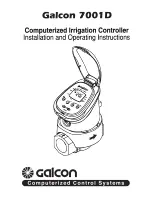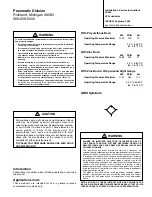
INSTALLATION AND MAINTENANCE INSTRUCTIONS
802-0002 Twinflex Input Module (Detector)
802-0003 Twinflex Input Module (Call Point)
26-0352 Issue 6
General Description
The Twinflex Input module is available to enable the Twinflex system to receive a fire input signal from the zone
circuit. This device is compatible with the Twinflex range of Fire Alarm equipment as an auxiliary input unit. The unit
consists of a boxed module which may be mounted within the unit to be monitored. Upon activation the module
generates a ‘DETECTOR ALARM’ or ‘MANUAL CALL POINT ALARM’ at the control panel depending on
speification.
Device Installation
All wiring must be installed in compliance with the recommendations laid out by BS5839 Pt1 : 2002 as well as any
special recommendations documented in the control panel installation manual. The cabling used should be of a 2-
core 1.5mm
2
screened, fire resistant type (e.g. MICC or FP200 equivalent), and is to be wired in the form of a
screened 2-core radial circuit (with no spurs) from the control panel, terminating at the last (“End of Line”) device.
Installation 1
st
Fix
Fix the interface (surface/boxed single gang) in a suitable position remembering to allow enough space for the
correct termination of the appropriate cables. The interface PCB must be mounted within 15cm of the contacts to
be monitored.
Installation 2
nd
Fix
Once all testing has been carried out on the cabling, and ‘continuity & integrity’ of the zone pair has been proven,
the interface unit may be connected and commissioned. Remember to set the end of line (EOL) switch to the on
position if the unit is the last device on the circuit. It is important to note also, that this input is a ‘latching fire input’,
and
is not
fault monitored.
I/P I/P
Z+ Z -
ON
EOL SWITCH
Connections
The cabling should be 2-core 1.5mm
2
screened/earthed and fire resistant e.g. MICC or FP200 equivalent type and
is to be in the form of a 2-core radial circuit terminating at the End of Line device.
No screen connection is allowed for within the device. Incoming and outgoing cable screens must therefore be
connected through using a suitable connector. It is important to maintain the screen continuity in order to protect
against data corruption from interference.
Requires Normally-Open
contacts, closing in the
alarm condition.
Mount unit near contact
(15cm max cable length
from module)






















